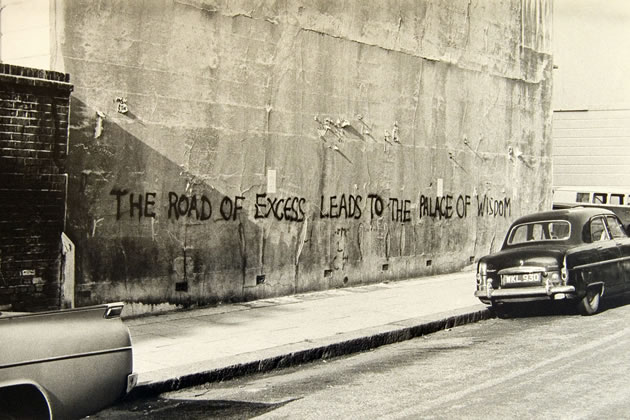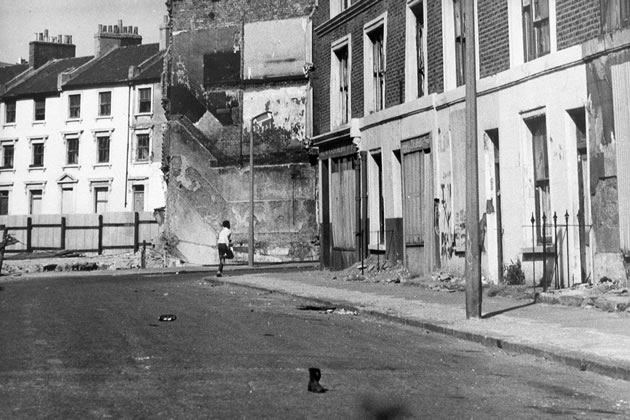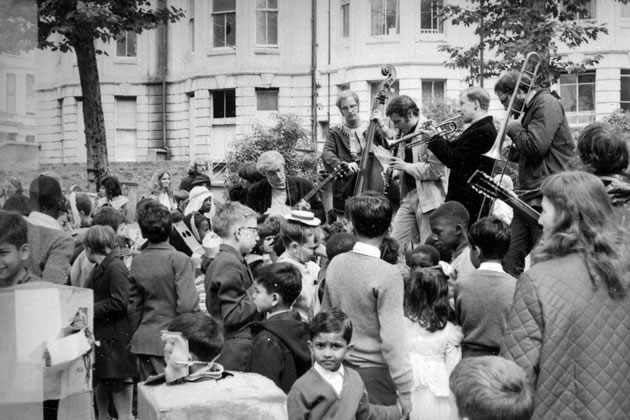The Fight To Save a Community Ripped Apart By The Westway
How people tried to make the best of having a motorway built through the area

Road Of Excess graffiti before the Westway was built. Picture: Adam Ritchie
April 12, 2021
“There was a dearth of open space in North Kensington. It was appalling,” recalled photographer Adam Ritchie who worked with residents to campaign for facilities when a motorway was built in the middle of the area.
“It was a mind boggling situation.”
The photographer who has photographed the Velvet Underground and Pink Floyd dedicated years to working with the community and photographing them as they campaigned for better facilities as the A40 was bulldozed through their neighbourhood.
In 1962 an Act of Parliament approved the building of the Westway – a 2.5mile mile road right between Paddington and North Kensington.
The government put in a quarter of the money for the Greater London Council scheme. It was designed to ease congestion and was originally planned as part of a scheme linking a proposed London Ringways network, which was later scaled back.
Work started on the £36.5million project in 1966 after 600 compulsorily purchased homes were demolished.

Blechynden Street before the Westway was built. Picture: Adam Ritchie
The road opened in 1970 and was the longest stretch of elevated roadway in Europe. Very soon 47,000 cars a day brought noise and pollution with them.
Mr Ritchie got involved as the community fought to get some much needed facilities in the 23 acres of derelict land the project created.

Band play in Powis Square. Picture: Adam Ritchie
He had just returned from New York where he’d been working and he visited his friend Hoppy who was involved in the free school adventure playground on Acklam Road and had started the International Times – an underground paper.
As 600 homes were being bulldozed to make way for the new motorway it was clear that people didn’t just want a car park built underneath. So Mr Christie joined with John O’ Malley to help the community draw up a wish list of facilities. He was inspired by watching children build “amazing structures” out of the rubble on the building sites for the road.
He then hid hammers, a saw and a big bag of nails under the rubble to help with their creative projects. “And there was non-stop creation, wonderful creation. I thought this has to be long term. They have to have somewhere safe in the future.”
And added to that, “It was clear that housing was appalling and there was a constant thing of kids being knocked down by cars.”

Acklam Road before Motorway. Picture: Adam Ritchie
So if a motorway was going to be built through the area the community were determined there should be some benefits.
Mr Ritchie said: “We were very careful how we were doing stuff. We had lots of public meetings. We got a big map of the motorway about 15 foot long. It was put up on the wall so all the cross streets were marked so people could read them and to make it very clear.
“We asked people what they wanted put under the motorway. It’s not a good space – but it’s better than nothing.”
The map was taken round church halls and schools to reach as many people as possible. Armed with pens and paper they stuck up their ideas. And whilst the authorities wanted a car park the community came up with some imaginative ideas.
“They wanted other playgrounds, they wanted community centres, they wanted a community laundry, they wanted cheaper shopping as shopping is expensive and more expensive when you are in a slum area, that’s what was happening. Rich people can bargain and they have better transport to reach other shops.”
Other ideas included putting a corkboard on the side of the motorway bay so schools could stage monthly exhibitions of art work.
And people called for playgrounds and sports facilities, a theatre, a youth club and even a creche next to Ladbroke Grove tube station where children could be looked after whilst their families went shopping.
“Some people wanted concrete chess tables and seats so people can have peace and quiet to play chess,” recalled Mr Ritchie.
“There was a war going on, this is what the people in power do to people who have no power. I have been angry for 55 years about this.”
And he said the prospect of having a motorway built through the area “confirmed what people thought, that they were worthless.”
Clearly he said, the opposite is true.
At the time 60 per cent of homes in North Kensington were overcrowded he explained “and we were constantly helping people who were squatting. Every story was worse than the one before”.
He shared just one memory of these appalling conditions – which still shocks fifty years on. Maggie lived in a basement with where conditions were so bad her two children had bronchitis. Families living across three floors had to share just one toilet, with one basin on each landing along with a gas cooker.
“It was indescribably bad. Maggie had waste water running down the walls,” he said.
She asked for help from the then Kensington council but to no avail and ended up squatting at a better property and eventually was housed out of London.
“The Westway was put where the poor were living. It would never be put where wealthy people were living.”
At one time he said the Westway was slated to run above Holland Park but he did not think that was ever really going to happen.
And he explained that as homes were knocked down the surrounding areas became more crowded. After a decade of community activism the North Kensington Amenity Trust was founded to look after the area for the community and spend money left for the community.
However right from the start there was disquiet as the then Kensington council set it up with councillors nominated to serve on the trust, rather than the community.
A few years later Mr Ritchie served on the trust.
“It was just a nightmare,” he recalled.
Eventually he moved to Wales and observed from afar what happened at the Westway Development Trust and later the Westway Trust.
This year as it marks its fiftieth anniversary the Westway Trust is working to rebuild community links after a damning report by the Tutu Foundation into institutionalised racism.
New chair of trustees, Toby Laurent Belson, hopes the next 50 years will build on supporting the community with a trust run by the people who live nearby.
And Mr Ritchie is keen to stage an exhibition of his historic photos and would like to hear from anyone who recognises themselves or their family and friends.
“I was trying to organise an exhibition above Portobello on the exhibition wall at Cambridge Gardens to celebrate all the things that people in North Kensington have done for themselves, like the UK’s first law centre, housing associations, community centres, Carnival and lots of other things, dedicated to John O’Malley who died last year,” he said.
“Now I’m hoping that the Westway Trust will organise it on their grounds when it is possible.”
Julia Gregory - Local Democracy Reporter